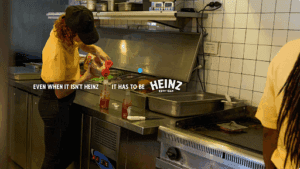
The data behind decades of Heinz advertising

For over 150 years, Heinz has done more than make ketchup — it’s mastered the art of advertising with a precision rooted in data. From early 20th-century campaigns built on consumer fears around food safety to AI-powered content analysis and social media testing in the digital age, Heinz has consistently used data to understand its audience, shape creative direction, and drive long-term brand loyalty. This blog explores the numbers, insights, and strategies behind some of Heinz’s most iconic campaigns — revealing how a blend of analytics, psychology, and creativity helped turn a condiment into a cultural symbol.
How data forms successful advertising
Advertising is a broad spectrum, and many catalysts create a successful advertising campaign – messaging, content creation, channels, targeting, and more- which are all key drivers in forming a renowned campaign. However, one element that ties it all together is data. Researching into who your audience are, their preferences, but also looking into the current market and competition and your chosen channels and platforms will form the basis of your advertising approach.
It’s equally as important to monitor the data gathered during the campaign. Ongoing evaluation of engagement, conversions, and attribution is essential, providing insights that allow for real-time optimisation and continuous improvement. It’s virtually impossible to have a highly effective and goal-achieving campaign without data at the root of it. Heinz is one brand that has continuously achieved success due to their data-led advertising campaigns. From consumer needs and wants to tailored messaging and market research, Heinz has ensured continuous customer reach and satisfaction due to their data-focused approach.
Heinz’s consumer behaviour
Heinz’s approach to consumer behaviour and how they have intertwined this into their long-running success, over 150 years worth, is made up of multiple factors:
Trust through transparency
From the early 1900s, Heinz built consumer trust by emphasising purity when food safety was a growing concern. They used clear glass bottles so customers could see the product and even opened factory doors to the public to reinforce hygiene—an early move in building brand transparency.
Consumer behaviour insight: Consumers are likelier to trust and remain loyal to brands that demonstrate transparency and quality.
Tapping into sensory experience
Campaigns like “Slowest Ketchup in the West” focused on product experience, visually showing the ketchup’s thickness to showcase quality. Heinz knew that highlighting quality through sensory elements such as sight, texture, and sound profoundly influences brand preference.
Insight: Demonstrating quality through product performance can improve consumer perceptions and provide premium positioning within the market.
Data-led personalisation
Heinz’s modern campaigns have leaned heavily on data-driven creativity, from analysing social conversations to tracking restaurant behaviour (e.g., ketchup fraud). Heinz tailored messaging that felt relevant and relatable by identifying patterns in consumer use and their loyalty to the brand.
Emotional loyalty
In recent years, Heinz has explored people’s irrational love for the brand — such as tattoos, carrying ketchup bottles in purses, and viral food pairings. These behaviours were evidenced in campaigns to celebrate brand loyalty and turn everyday users into brand ambassadors.
Insight: Tapping into genuine, emotional connections can drive advocacy and long-term loyalty — especially when consumers feel seen by the brand.
The early days: Building trust (1900s–1950s)
Heinz’s position within the market was solidified in the 1900s when they based their marketing strategy around product purity; this was particularly important as it was a post-industrial revolution, and as a result of this, there was a new growing fear of food contamination living amongst homes. Ensuring that Heinz encapsulated the particular message of product safety allowed them to stand out against competitors and any other ‘household brands’. Using clear bottles and messaging saying ‘pure food products’ built trust between the brand and consumer, which is still reflected to this day. During this period of time, Heinz actually opened their factories to the general public to provide them with the opportunity to see the cleanliness for themselves, building upon and cementing that level of authentic trust. By understanding their consumers’ needs and challenges, Heinz was able to satisfy their customers’ needs and wants.
The rise of brand recognition (1960’s to 1980’s)
Heinz continued to maintain their place as a market leader when they launched their campaign ‘Slowest Ketchup in the West’, the purpose of this campaign was to show the quality of their products against their competitors. They wanted to showcase the thickness of their sauce to highlight how all their ingredients were pure and natural, they did this by showing their product side by side with another, pouring out both products. This showcased how ‘slow’ Heinz’s ketchup was to leave the bottle, showing its thickness and that pure ingredients are used, in comparison to their competitors.
With sales boosting, so was consumer perception, now viewing Heinz as the superior brand against competition. Although there are no public records to highlight the actual figure in sales from this campaign, a 1985 article from the Los Angeles Times provides some insight into the ketchup market during that period. According to the article, in 1985, consumers purchased $491 million worth of ketchup, up from $370.4 million in 1980, indicating a 32.6% increase over four years. Heinz researched and understood what their audience were looking for in a brand, and simply delivered.
Digital transformation (1990s–2010s)
From the 1990’s to now, there has been a huge shift amongst advertising with access to more detailed consumer metrics, insights, as well as new ways of connecting with consumers through email marketing, AI and the rise of social media, opening doors to new ways of building relationships with audiences.
In the early 2000’s Heinz began to use email marketing features and customer relationship management (CRM) to connect more directly with their customers. In 2005 specifically, Heinz created a CRM campaign aimed at mothers, with the idea of launching an email newsletter. However, research revealed that only 3% of their target demographic were actually interested in receiving emails from the brand itself. Learning this information, Heinz then went down an alternative route, using a direct mail strategy, distributing physical, personalised recipe booklets alongside vouchers to personally engage with their audience in an effective way (Campaign Live, 2005). This highlighted that that specific audience group prefers physical mail. Using that data they were able to connect with their dedicated customer group in the exact way that they wanted to be reached, building a stronger relationship.
Earlier, in 2003, Heinz explored email newsletters as a promotional tool. Their first newsletter offered a 40p coupon for a new ketchup variant, resulting in approximately two-thirds of recipients printing the coupon. The company tracked user interactions, such as coupon usage and link clicks, to gather insights. Initially, all subscribers received the same content, but Heinz planned to implement segmentation based on user behaviour to deliver more personalised communications (Campaign Live, November 2003). Heinz continued to roll out this newsletter after the initial success with the marketing manager, Peter Ebsworth, at the time saying “As we see how people respond, we can become more targeted about what we send people,” – and this same thought process is just as relevant today.
This decision highlights Heinz’s commitment to data-driven marketing, ensuring their communication methods aligned with consumer preferences. While email marketing was gaining traction during that period, Heinz prioritised channels that resonated more with their customers, demonstrating a nuanced understanding of their audience.
The modern era: Data-led creativity (2020s–Present)
Data is just as prominent and needed now for successful marketing campaigns, and in this decade, Heinz has shown how it still works just as effectively. Consumer preferences change all the time, and that’s why data is still needed to determine the best and most effective ways to entice and engage your audience.
Heinz’s “It Has to Be Heinz” umbrella campaign, launched in 2023, had two major campaigns, with the goal to increase their market share after facing a decline and also re-connect with their consumers on a personal, relatable level, they spent 5 years conducting information, and the two that stood out the most were:
Approach 1: Authenticity and trust
To increase authenticity and trust around the brand, Heinz created, “ketchup fraud” – which tackled the idea that restaurants refill Heinz bottles with non-branded, generic ketchup to supposedly cut costs. This widespread familiar take was brought to light through social media, including a viral image of a Nando’s employee refilling a Heinz bottle with an unbranded substitute. Heinz caught on to this and thought it would be the perfect strategy behind their campaign, as they soon realised they were missing out on sales volumes.

So how did Heinz approach this? Well, they actually supplied those ‘fraudulent’ restaurants with Heinz ketchup, taking a positive and leadership spin on the whole essence, they also took their marketing efforts a step further by asking participants to report instances of ‘Ketchup Fraud’. This engagement not only drove consumer demand but also reinforced Heinz’s commitment to quality and authenticity. This campaign was also rolled out in Turkey, with the approach of ‘Is That Heinz?, created with Wunderman Thompson, and the results led to 97% able to discern real Heinz ketchup from imitations, which resulted in a 73% decrease in non-Heinz ketchup refills and a 24% increase in Heinz ketchup usage in street food restaurants (Contagious, 2023).
The campaign’s impact was significant, with Rethink, the brains behind the creative campaign reporting on:
89% Positive Sentiment
128x engagement rate benchmark
+33 new partner locations in under a month
+8% sales vs. the previous year.
Approach 2: Emotional connection
To connect on an emotional level, Heinz used consumer research to build a campaign highlighting all the wonderful ways their customers use Heinz Ketchup, from tattoos to wacky food combinations, and carrying Heinz in purses. Winning the Creative Effectiveness Lions Grand Prix at the Cannes Advertising Festival, this campaign was one of their biggest yet, due to the personal touch with real life customer stories that the general public could relate to. Using consumer driven data and researching their most committed consumers, discovering that they all shared one thing: “the irrational lengths they go to for Heinz products,” stated Diana Frost, chief growth officer, North American Zone at The Kraft Heinz Company. The data behind this successful campaign was found through social media, news articles, and through word of mouth.

Winning the 2024 Creative Effectiveness Lions Grand Prix at the Cannes Advertising Festival, this campaign was one of their biggest yet, due to the personal and relatable touch with real life customer stories. On top of this prestigious award, they also earned a Graphite Pencil for Press and Outdoor at the 2023 D&AD Awards, and a Gold Lion in the Outdoor category at Cannes.
The overall success of this campaign?
- Over the past five years, Heinz’s US retail sales surged by nearly 50%, reaching $851 million in 2023. (Print Power, 2024)
- In 2024, it was awarded the Grand Prix in Creative Effectiveness at the Cannes Lions Festival. (Contagious, 2024)
- A 12% year-over-year global ketchup sales growth since 2019. (Kantar)
- Achieved ‘Iconic’ Brand Status: In 2023, Heinz became one of only 4% of brands to achieve the ‘Iconic’ status in Kantar’s brand measurement. (Kantar)
https://www.youtube.com/watch?v=xb1YbasuxPU
Overall, the “It Has to Be Heinz” campaign has significantly brought the brand back to life, driving substantial sales growth, earning highly prestigious industry awards, and enhancing its cultural relevance and consumer loyalty.
Takeaways: What brands can learn from Heinz
Consistency doesn’t mean you’re not moving forward. 68% of consumers find that a brand maintaining consistency is more trustworthy than not, as it simplifies the decision-making process for the consumer and builds confidence that the brand will provide consistent quality and service each and every time.
Data doesn’t kill creativity—it fuels it. Data is very much the backbone of creativity. How else can you speak to your consumers creatively if you don’t research their preferences, trends, and patterns of behaviour? Doing so allows ideas to develop that are more relevant and impactful, creating successful results.
Customer obsession + storytelling + data = timeless marketing. Building a brand where customers essentially become ‘fans’ of it is one of the best approaches to success. Heinz has become such a household staple that their audiences commit to tattoos, knowing their love for the brand won’t ever change. Heinz has used data throughout its life cycle to build a strong brand consistently for 150 years through their storytelling approach, creating personalised campaigns and researching their consumers in depth.



